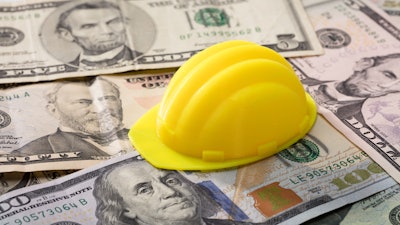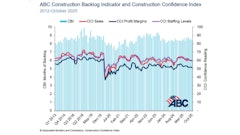
Last year, lawmakers in Washington passed a $1.2 trillion bipartisan infrastructure plan, injecting billions of dollars directly into repairing crumbling highways, strengthening shipping ports, modernizing airports, and other vital projects for the next decade. This plan represents the largest overall infrastructure investment in U.S. history, and potentially the most impactful since the New Deal ushered in rural electrification, municipal water systems, and the Hoover Dam, or the creation of the Interstate Highway system in the late 1950s.
The new projects are now breaking ground across the country, which will energize the construction industry. These new opportunities, however, exacerbate the two core challenges subcontractors face every day: how to pay the rising costs of materials along with how to recruit and keep skilled workers.
Large public infrastructure projects are fantastic for creating jobs, but they also significantly increase demand for materials, which are already under strain. Since 2019, material prices across the construction industry have skyrocketed. In 2021 alone, flat steel prices rose 131%, lumber prices by 32% and copper by just a little over 50%
These price surges occurred for many reasons—from increased demand to environmental disasters such as wildfires, to rising fuel prices. According to the U.S. Chamber of Commerce, 95% of contractors are expecting to experience at least one product shortage. How can subcontractors bid on their next project if the price of materials remains so volatile and prices continue to rise?
Concrete contractors have been hit particularly hard by rising prices. During the pandemic, concrete prices have risen dramatically. In fact, ready-mix concrete prices rose from $128 in January 2020 to $142 today (for the South Region of the U.S.), an 11% increase. Concrete demand rarely falls because, unlike other building materials, concrete is critical to every building project—residential, commercial, or industrial, and infrastructure investment will only further increase demand.
While steadily rising material prices push subcontractors to the financial brink, an equally critical challenge is the battle to secure skilled workers. A recent study by the US Chamber of Commerce found 91% of contractors had moderate to high difficulty obtaining skilled workers. Of that 91%, a staggering 62% reported their difficulty as ‘high,’ up 20 points from 2020. To keep up with booming demand, the construction industry needs to add 2.2 million additional workers by 2025.
Other industries are dealing with the labor shortage by simply raising wages, an option not available for subcontractors. Construction workers already earn 46% more than the average $11.26 hourly U.S. wage. By raising wages, adding in new incentives, plus the sky-high material prices, a contractor will have to raise the price of their project and pass that difference onto consumers. Even then, it would do little to significantly increase the inflow of younger skilled workers into construction. Add potential wage strikes in high-growth areas such as Seattle, it’s no wonder concrete subcontractors feel under siege.
These recent developments highlight the core issue, that the payment cycle in the construction industry has been broken for decades. Subcontractors are at the end of the payment road, often waiting 90+ days to get paid for completed work, thus limiting their potential to bid on another project. Relying on cash on hand is far too unpredictable to comfortably pay for labor or materials upfront, much less reliably finance the sizable expenses that come with scaling a construction business.
Possible Solutions to Succeed & Grow
One way out of the cycle is for subcontractors to go to traditional banks, which are often unwilling to offer financing to subcontracting businesses due to up and down cash flow, let alone younger companies without a proven financial history. Another option is to find some form of an alternative lender, but this choice often ends up being cost-prohibitive and is not tailored for construction businesses. To not just survive but thrive, subcontractors need more ways to secure capital.
Fortunately, new financing solutions are helping subcontractors’ commercial construction projects come to life. These new financing options are ideal because they are specifically designed for subcontractors, allowing project materials to be purchased with 120-day terms that align with payment cycles.
An effective material financing solution pays suppliers fast and upfront, providing subcontractors with funding for same-day purchasing, locking in the best prices. Flexible financing options ensure the materials come in, suppliers get paid, and subcontractors have more time to pay. They help build and strengthen a healthy relationship between subcontractors and the suppliers. Material finance solutions also prevent costly price hikes and help subcontractors receive cash discounts.
Subcontractors face similar challenges when dealing with labor costs. When they’re not paid on time—which can happen frequently—subs must pay out of pocket for labor which puts undue stress on their business and strangles cash flow. Advance pay options provide same-day financing to cover labor costs and provide a stable, secure source of revenue, eliminating the responsibility of the subcontractor to float their own capital to fund projects and pay their workforce. Designed specifically for subcontractors to guarantee quick payment, and with up to 120-day repayment terms, labor advance solutions can help subs more effectively manage expenses throughout the entire project.
Subcontractors hammered by skyrocketing material financing costs and the pernicious construction labor shortage need more help. With demand still rising and few options to quickly increase the number of workers, subcontractors need safe, reliable options to help bridge the gap in their outgoing payments and incoming cash flow. Contractors and subcontractors will need to adapt and take advantage of new tools if they want to succeed and grow.
About the author
Christopher Doyle, co-founder and CEO of Billd, is an entrepreneur and business leader with extensive construction industry experience and a record of launching successful startups.


















